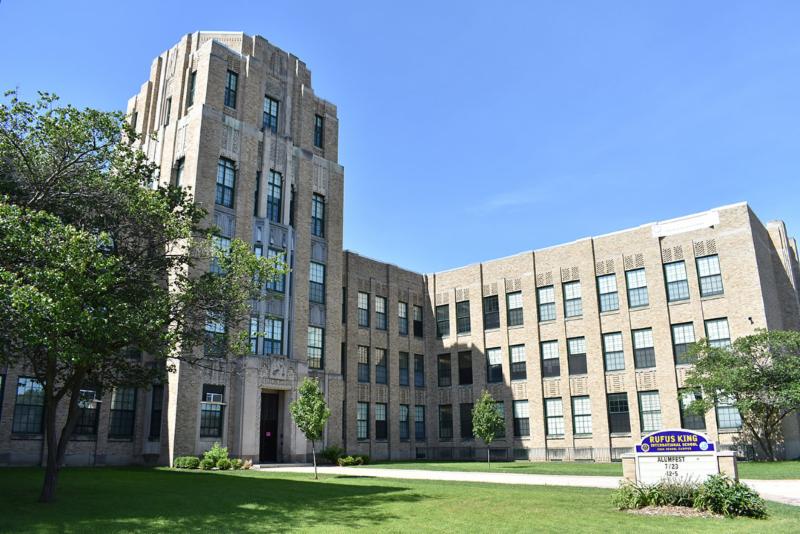MPS Becomes Issue in Governor’s Race
Budget cuts, poor achievement, Walker’s call for state action heat up discussion.
There is a way to address the consistent underperformance of Milwaukee Public Schools, but it will take a nonpartisan effort to do that, said education columnist Alan Borsuk.
But that’s not likely to happen, especially in an election year with a race for governor, admitted Borsuk, a senior fellow in law and public policy at Marquette University Law School and an columnist for the Milwaukee Journal Sentinel.
For example, incumbent Gov. Scott Walker‘s recent suggestion that the Milwaukee school system be divided into smaller districts could encourage more favor from his supporters, who might perceive him as taking a tough stance on the troubled district.
Conversely, democratic candidates for governor, including Tony Evers who heads the state Department of Public Instruction, align with school supporters when criticizing the current governor for cutting aid to the district in recent years.
But playing political football with Milwaukee Public Schools’ “formidable” problems probably isn’t the solution, Borsuk said.
“The situation in Milwaukee in general and Milwaukee Public Schools specifically is getting to a point where we really need to sit down and figure out what’s best for the kids of the city because this is so central to the future of the state and the state’s economy,” Borsuk said.
Current issues in the district span from budget constraints to an unhappy workforce:
- MPS’s most recent budget proposed cutting about $11 million from the district’s $1.17 billion budget. That’s an attempt to make up for an expected $38.7 million rift this coming year between expenses and revenue, the Milwaukee Journal Sentinel reported. A five-year budget forecast shows that gap expanding to $78.7 million the following year and increasing each year to $177.1 million in the 2022-23 school year.
- District administration proposed unpopular cuts to accommodate that revenue gap, including eliminating busing services that would impact about 1,000 students and have employees pay more for health insurance.
- Anger over proposed cuts has ripened hostility toward the district and school board, driving a frustrated workforce to action. In April, members of the Milwaukee Teachers’ Education Association spoke out against the proposed cuts, calling cuts to students services “unconscionable” and advocating for a cost of living increase for staff.
- The district has 76,000 students, and that number has declined in recent years. In the 2005-06 school year, the district enrolled more than 92,000 students, according to the public school database system WISEdash. That could be another threat to the financial vitality of the system, because districts per pupil aid totals depend on the number of students enrolled.
- Most students in the public schools in Milwaukee aren’t performing to standard either. WISEdash data show that in the 2016-17 school year, for which the latest data was available, 20 percent of students performed at a proficient level in English Language Arts on the Forward exam. That exam tests students in grades 3-8 in English and mathematics.
While that means about 6,000 of about 30,000 who took the test are proficient, students statewide are faring better, with about a 44 percent (163,000 students) proficiency rate on the English exam.
Additionally, the district’s superintendent, Darienne Driver, is leaving the district at the end of this school year for a position as president and CEO of the United Way for Southeastern Michigan.
State Intervention
Walker’s proposal for state intervention at MPS isn’t new. In fact, Walker and governors from the past two administrations tried to solve problems at the state’s largest district by pushing the idea of outside oversight.
In 1998, then Gov. Tommy Thompson gave the school district an ultimatum. If it didn’t improve student grades and graduation rates and reduce dropouts, the state would intervene. But nothing ever came of it, Borsuk said.
In 2009, former Gov. Jim Doyle wanted to create a governing system controlled mostly by the Milwaukee mayor. But Democrats in the legislature shot that plan down, Borsuk said.
Also in 2009, Walker, who was running for his position at the time, said he wanted to split the district up into smaller districts about the size of the Wauwatosa School District, where his own children attended school. Last year, Wauwatosa enrolled about 7,100 students in its district.
Then, in 2015, the Opportunity Schools and Partnership Program was established to pull low-performing schools from the district and house them under other operators, such as the program’s commissioner, Borsuk said. While the program still exists, the commissioner has since resigned.
“That became hugely controversial but didn’t produce anything,” he said. “There’s a theme here of big ideas producing nothing.”
Answers to the question of whether change at the top is needed to produce better performing schools depends on who’s asked, Borsuk said. The school board getting in the way of change might be the belief of people in the business community, republicans and some civic leaders, he said.
“On the other hand, I think the general public sentiment in Milwaukee at the street level would be very opposed to that,” he said. “They don’t want outsiders coming in and forcing anything.”
The actual act of splitting up the district would be complicated, Borsuk said, especially trying to untangle the mesh of school choice programs that are now a part of the district and figuring out how that would play out with the private school voucher program and charter schools.
Additionally, that proposition poses questions of what schools stay open, which teachers would be assigned where, and what schools students would attend.
“It’s easy to advocate; this is one enormously scrambled egg,” Borsuk said. “It’s really hard to see how you would unscramble it.”
Listen to the report here.
Milwaukee Public Schools Under Scrutiny In Governor’s Race was originally published by Wisconsin Public Radio.






















State should dedicate a portion of sales tax revenue to MPS pension costs, County Pension costs and City of Milwaukee public safety. MPS could break up and start over, county could take care of parks and maybe public safety wouldn’t account for more than 50% of property taxes. If you break up MPS you’ll need someone to take care of the costs left over from the baby boomers.
The answer is NOT to hollow out MPS by continuing the privatization of education via vouchers. I’m not advocating for his candidacy one way or the other, but Andy Gronik recently released a plan that is not the “abolish vouchers on day 1” approach. I’d love to hear pros and cons from people with children and/or experience with the district. https://www.andygronik.com/plans/education-plan/
Republicans would prefer to keep their favorite whipping boy barely alive than do anything substantial about it. Looking down on MPS plays well in the sticks, so why do anything real about it? That’s their attitude.